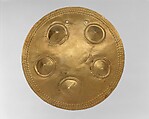Pectoral Disk (Patena)
Not on view
Works of hammered sheet gold are usually higher in gold content than are cast objects, and disks or breastplates are most commonly made from it in Central America. Ranging in size from about four to eight inches in diameter, the disks usually have two holes close to the edge, suggesting they were worn as chest ornaments, either fastened to a garment or neckband. Many pectoral disks, also called patenas, are striking in their simplicity, with brilliantly polished, highly reflective surfaces, their only decoration rows of raised dots around the rim. Others have large, centrally spaced bosses, as on this example, and some incorporate complex figural designs. Metalworkers in Central America favored lost-wax casting over hammering for the manufacture of most of their gold objects.
In the early 1500s, when Christopher Columbus sailed along the Caribbean coast of present-day Costa Rica and Panama, he reported seeing the Indians wearing "mirrors" around their necks. It is possible that he was referring to the gold disks reflecting the sunlight like mirrors.
Due to rights restrictions, this image cannot be enlarged, viewed at full screen, or downloaded.


